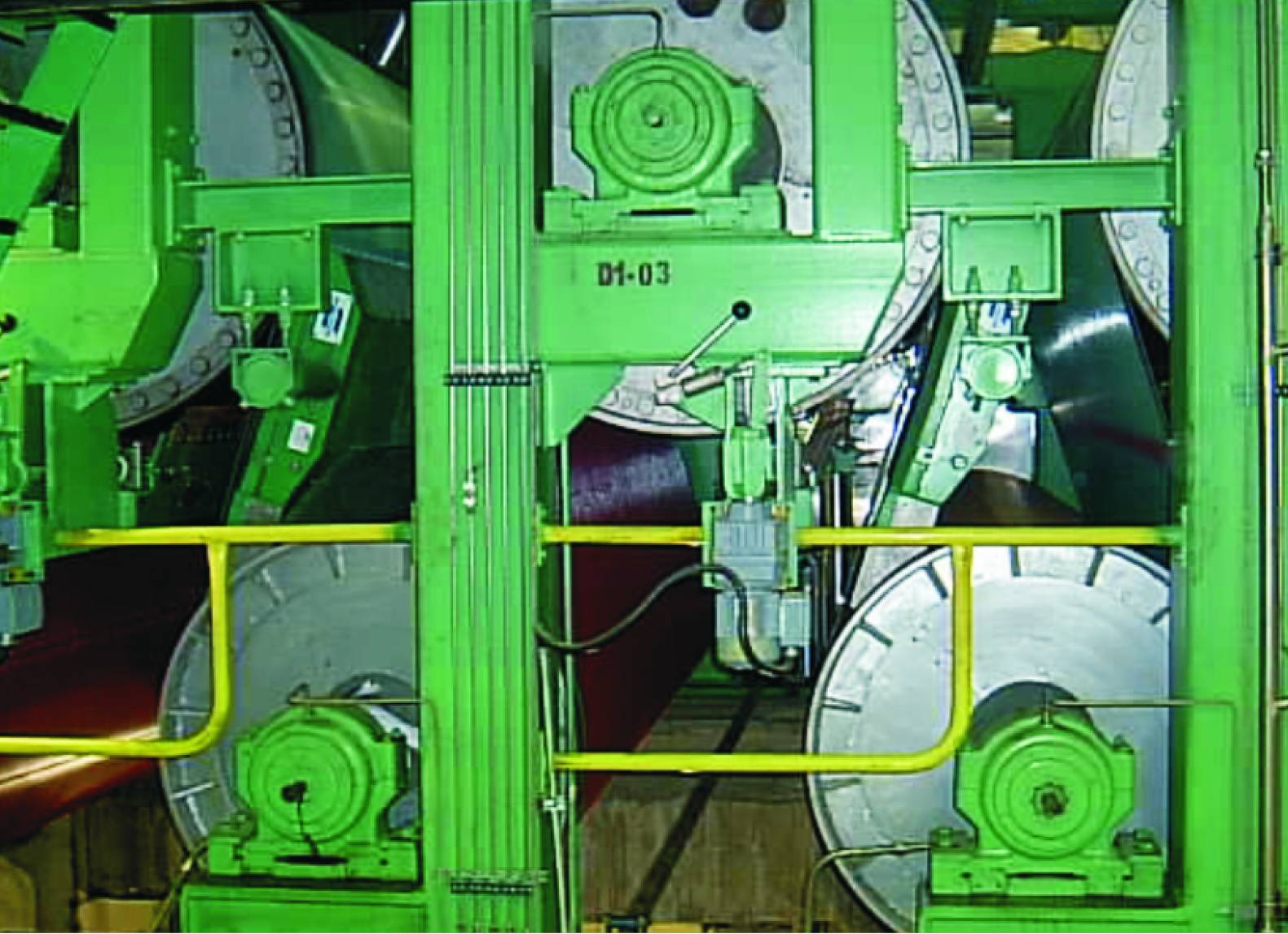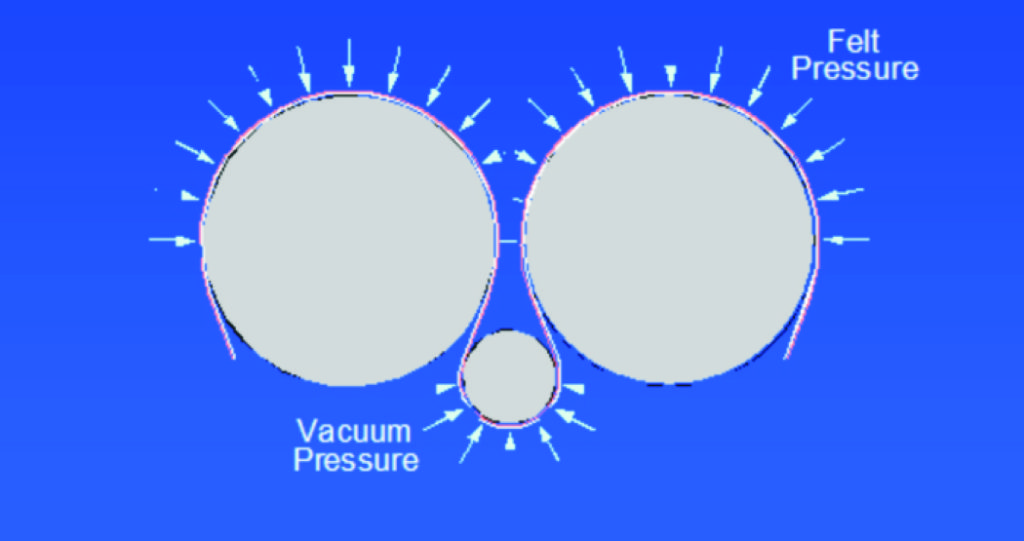Uno Group of Drying Cylinders
UNO group of drying cylinders is a modern technological solution used for higher speeds of paper machines. Its advantage is, the paper is permanently held by the fabric on the drying cylinder, by the under-pressure on the Vacroll and by stabilization boxes between the cylinders (used for machine higher speeds). From these reasons, the uno-groups are advantageous from the point of view of the production runnability (reduced probability of breaks in the drying section). In addition, the paper contact throughout the drying track reduces its shrinkage and brings a better final profile of the paper.
An important criterion for the installation of the uno-group is the fact that there is a strong circulation on the surface of drying cylinders and centrifugal forces increase at the speeds above 1.200 m/min.
In such case, the installation of Vacrolls and stabilization boxes (of the uno-group) is a necessary condition for the stabilization of the paper behaviour during the drying process. At this speed, the frequency of paper breaks, wrinkles and a number of other defects starts to increase with a classical two-fabric drying group.
Depending on the machine speed, the paper type and the available investment sources, uno-groups are primarily used as the first groups of the drying part or the first groups of the after-drying part (after the size press or the film press).
This is the place where the uno-group is the most beneficial for the machine runnability with respect to the paper moisture and its tendency to break.
As far as the produced type of paper is concerned, the combination of a unogroup and a classical drying group is used for higher basis weights having an increased tensile strength and the unogroups in the entire length of the machine would not be so beneficial.
Difference between a classical drying cylinder and a Vacroll
In the given UNO-group, the Vacroll usually has a smaller diameter than the drying cylinder and it is installed in the bottom row. Its construction is adapted to the selected under-pressure solution From this point of view, the cylinders are designed in two different ways:
- The under-pressure is induced through a hollow pin of the cylinder (on the service side or on the drive side), the coating is bored (bores are often complemented with grooves for a better distribution of the underpressure on the cylinder surface) and the internal construction of these cylinders contains a suction zone, delimited with seal bars. Stabilization boxes are often mounted for the stabilization of paper track between the cylinders at higher speeds.
- The under-pressure is induced through a suction box mounted in the space between drying fabrics. In such case, the Vacroll is only perforated and the suction takes place through the perforated coat towards the suction box above it. Such boxes usually have several zones and besides the suction effect towards the cylinder, they often have side stabilization zones with a side narrower separate zone for the paper threading.
The uno-group drive is used either with the use of a pin on the Vacroll (if the underpressure input is through a pin on the service side or through a suction box above the cylinder), or with the use of slip-on gearboxes of drying cylinders.
Used diameters of the cylinders
The design of the Vacroll diameter is related to the overall design of the drying part and particularly the size of drying cylinders. The Vacroll diameter is always smaller than the diameter of the drying cylinder, Ø 900 mm, Ø 1.000 mm, Ø 1.200 mm, Ø 1.800 mm etc. being used as standard sizes. Sometimes, Ø 1.290 mm, Ø 1.450 mm are also used and it all depends on the manufacturer and its standards. A typical construction of the uno-section comprises drying cylinders of Ø 1.500 mm together with Vacrolls of Ø 1.200 mm or drying cylinders of Ø 1.800 mm and Vacrolls of Ø 1.500 mm.
Recommended under-pressure
The cylinders work with an under-pressure of about -2 to -3 kPa on the flange intake. The under-pressure is produced by a ventilator dimensioned for the total suction surface of the used cylinders. The ventilator is connected with a piping to the cylinders through throttles. The output is led to the exhaust shared with the hood ventilation.
Valorisation of the application of the UNO group in the drying part
Besides the above-mentioned reduction of wet paper breaks, the advantage of the uno-group includes the possibility to use a no-rope air threading and an easier cleaning of the space between the rolls, should the break happen. Another advantage is an easy installation of the steam box for the control of the moisture profile (the steam profiler may be placed against the track of the paper held on the Vacroll).
Disadvantages of the “Uno group” include the decrease of the drying capacity per length unit of the machine (the drying part has to be longer), higher operation costs connected with the source of the underpressure of Vacrolls and stabilisers and, of course, higher investment costs at the beginning of the project.
Construction design and machine safety are in compliance with EU and EAC standards.
Recommendations for the installation of UNO-groups:
- For light papers and speeds from 800 m/min and for heavier basis weights and speeds above 1.000 m/min, primarily only as the first group of the pre-drying part and the first group of the after-drying part (in case a size press or a film press are installed)
- For all papers and machine speeds above 1.200 m/min following the rule – a higher speed and a lighter basis weight of the manufactured paper mean more UNO-groups
The picture bellow shows the principle of the paper web guiding. When the paper passes through a classical drying cylinder, it is held between the drying fabric and the hot cylinder coat and the drying fabric tension presses the paper onto the hot surface of the drying cylinder increasing the drying efficiency. On the contrary, when the paper passes through the Vacroll, the paper is held by the roll under-pressure and a part of vapours produced during the drying on the drying cylinder is sucked in the direction to the cylinder. The passage of the paper between the rolls is stabilized with the help of special boxes.
-
Category
Cultural / Industrial Length
4 feetWidth
6 feetHeight
10 feetWeight
580 kgSpace Require
14 sq. feet

Company Presentation
[elementor-template id="3268"]


